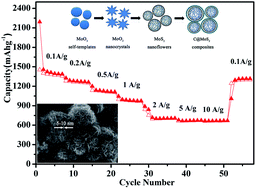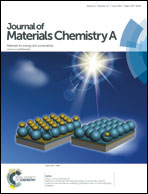Preparation of carbon coated MoS2 flower-like nanostructure with self-assembled nanosheets as high-performance lithium-ion battery anodes†
Abstract
Loosely packed MoS2 nanosheets with thin carbon coating were synthesized via a facile, one-pot hydrothermal growth method. In the resulting optimally-designed nanoarchitecture, the ultrathin nanosheets, with a wall-thickness of approximately 5–10 nm, provide a large electrode–electrolyte interface so as to facilitate faster lithium-ion intercalation and diffusion. The flexible and conductive carbon overcoats stabilize the disordered structure of flower-like MoS2 nanosheets to accommodate more lithium-ions intercalation and thus maintain the structural and electrical integrity during cycling processes. In favor of the synergy and interplay of the carbon effect and intrinsic structural advantages, C@MoS2 (2 : 1) composites synthesized with a D-glucose precursor: MoO3 molar ratio of 2 : 1 exhibit high reversible specific capacity of 1419 mA h g−1 at 0.1 A g−1, retain 80% of the capacity after 50 cycles, and excellent rate capability as high as 672 mA h g−1 at 10 A g−1 with nearly 100% coulombic efficiency. The good electrochemical performance suggests that these C@MoS2 composites with unique flower-like morphology could be a promising candidate as an anode material for lithium-ion batteries.


 Please wait while we load your content...
Please wait while we load your content...